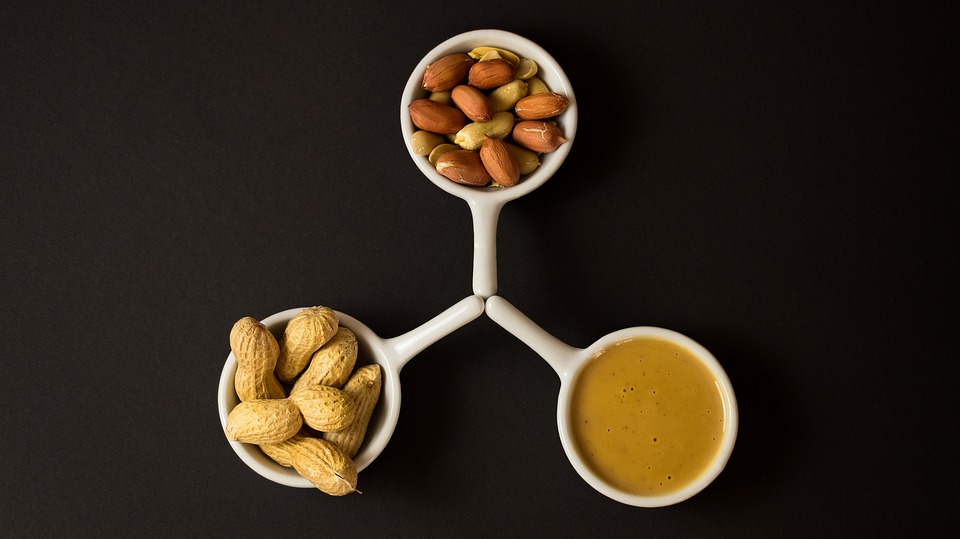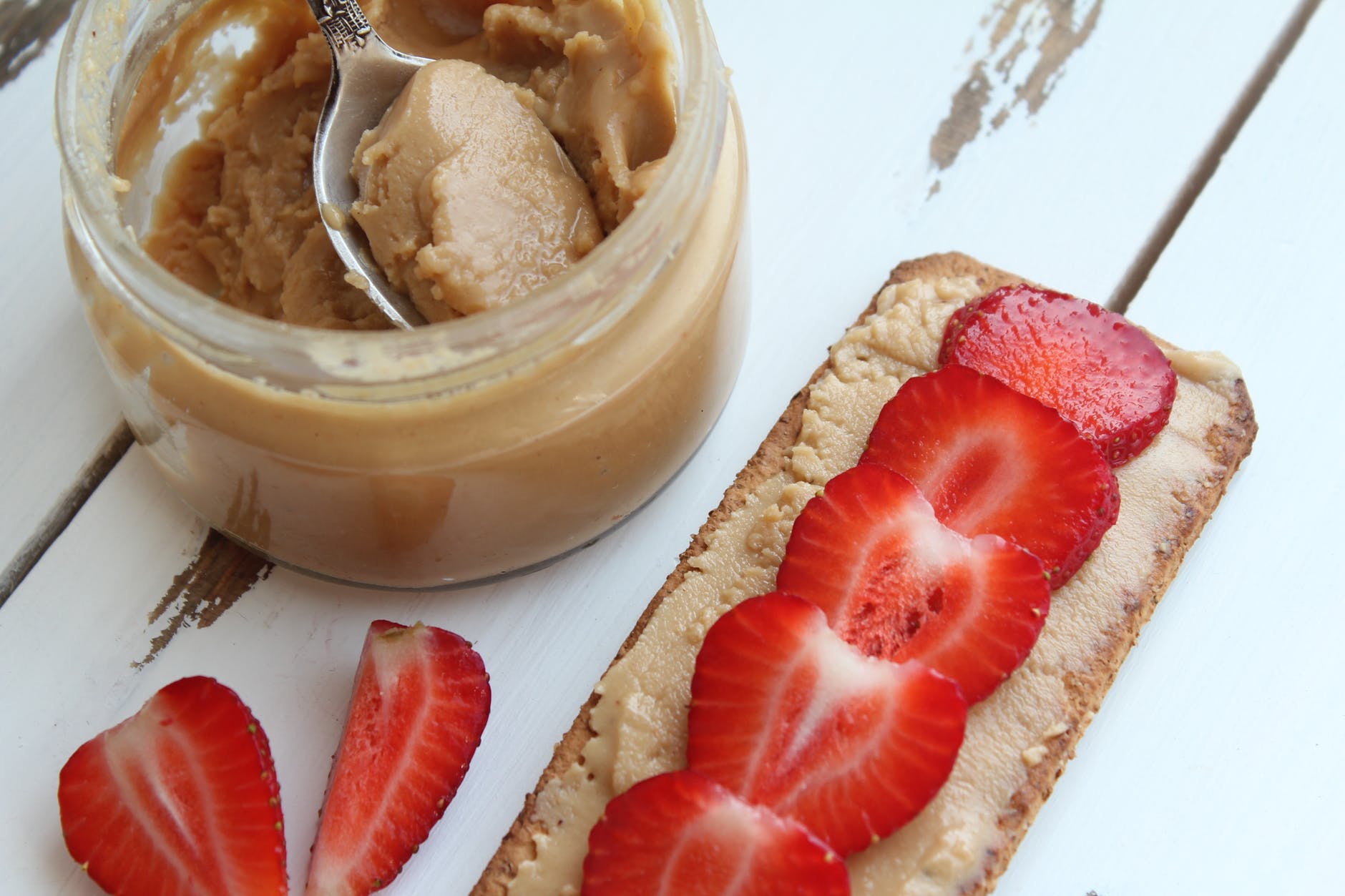“I love peanut butter but I don’t buy it. Otherwise I over-eat it.”
“Peanut butter is so fattening—but so yummy.”
“Is almond butter better healthier than peanut butter?”

Peanut butter is, without a doubt, one of the most popular sports foods around. Ask runners what they eat before a marathon, and the majority will say, “Bagel with peanut butter.” Ask cyclists what they eat during a century ride, and the answer is inevitably “Peanut butter and jelly sandwiches.” Assuming you are not allergic to peanut butter (PB), you might love it, but you also might have a love-hate relationship with this popular food. You love it so much you can easily end up eating a lot of it. You hate it because you fear it will contribute to fat gain and health problems. Hence, the goal of this article to erase the hate so you can love eating PB guilt-free, without negative consequences.
Note: Peanuts grow underground and are technically a member of the legume family, along with beans and peas. They share a nutrition profile similar with tree nuts, so we can get lump them into the same conversation. Hence, the information in this article relates to not just peanut butter but to all nut butters.
Is peanut butter fattening?
PB is not inherently fattening. If anything, people who eat peanuts, nuts, and nut butters are slimmer than nut avoiders. This fact is based on data compiled from ~576,000 people followed for, on average, about 18 years (1). Higher nut and PB intake was associated with lower body weight, a smaller waist, and weight loss. PB eaters did not have a higher BMI or percent body fat. If anything, eating PB, nuts, and nut butters seemed to have a protective effect against weight gain.
How can such a high-fat food be slimming?
The warning we once heard to limit foods high in fat and calories has proven to be unwarranted. The fat in PB is satiating. A PB sandwich keeps you feeling fed for longer than, let’s say, a turkey sandwich. Having fat in each meal also makes the meal taste better. Fat carries flavor. A spoonful of yummy PB pleases the taste buds, so you’ll be less likely to go poking around the kitchen looking for something else to eat, like ice cream. This can spare you from excess calories…
Should I pour off the oil that rises to the top of the all-natural PB jar?
Pouring off the oil leaves you with a lower calorie product, but it is less-yummy and less health-protective. Of the 14 grams of fat in a tablespoon of peanut oil, 10.5 are from “good” health-enhancing fats. Peanut oil is a source of vitamin E, an anti-oxidant that knocks down inflammation. People who eat PB, nuts, and other health-promoting oils five or more times a week have a reduced risk of heart disease and Type 2 diabetes. Why suffer through dry, less tasty, less health-protective PB when PB is not “fattening”? Storing the jar upside down can erase the oil-on-the-top issue.
Is PB better for pre-exercise fuel or post-exercise recovery?
PB, being primarily protein and fat, is a slow-to-digest fuel as compared to grains, fruits and vegetables (carbohydrates). Protein and fat take far longer to digest, so they are a poor choice for quick energy before you exercise. That said, if you will be doing a long workout that lasts for more than 1 to 1.5 hours, having PB before you exercise will offer sustained energy. It also can help buffer an influx of sugary gels and sport drinks.
After exercise, the fat and protein in the peanut butter will poorly refuel your muscles. The preferred recovery food offers three times more carbs than protein. Hence, a better choice is a PB & banana sandwich or pasta with a spicy Thai peanut butter sauce. That spoonful of PB straight from the jar will fill your tummy, but it will not rapidly refuel your muscles.
What’s the preferred type of peanut butter: organic? unsalted?
- Most long-term health studies have followed typical Americans who eat PB that is processed (hydrogenated) to keep the oil from separating out. Hydrogenation can create a bad trans-fat, though the amount of trans-fat is small, less than 0.5 gram per serving. (Negligible amounts show up as 0 grams trans-fat on the Nutrition Facts label). The health benefits of any type of PB seem to outweigh any potential negatives, but in general, less processed foods (of any type) are preferable to highly processed versions.
- Organic PB is nutritionally similar to conventional PB, but has a higher price tag, jumping from about 20 cents to about 37 cents per serving (2 Tbsp). Pesticides in PB are negligible. “They are sprayed on the ground before planting and disintegrate quickly; they have a very short half-life,” reports a Teddie PB spokesperson.
- The amount of sodium (the part of salt attributed to high blood pressure) in Jif is 135 mg/serving, similar to the amount in a slice of bread. This is not very much sodium, given the recommended intake is 2,400 mg. sodium a day. (The “average American” consumes 3,400 mg/day). As a fit, healthy, lean rower who likely has low blood pressure, do you need to limit your salt intake, given you lose salt in sweat? High blood pressure tends to be rooted heavily in family genetics, lack of fitness, and being overweight.
Is almond butter better than peanut butter?
Almond butter is far less sustainable that PB and is far more expensive, but it is equally nourishing. The subtle nutritional differences are insignificant, in context of your entire day’s food intake. In terms of planetary health, almonds have a much higher water footprint compared to peanuts (80.4 gallons water per ounce of almonds vs 4.7 gallons for peanuts).
What about PB with flax?
Some peanut butters contain flax. Flax is among the richest sources of ALA, a plant-based omega-3 fat that is deemed anti-inflammatory and heart-healthy. A tablespoon of flax seeds offers about 2,350 mg ALA; a serving of peanut butter with flax might offer only 300 mg ALA. Given the recommended intake of ALA is about 2,000 mg/day, it seems like the addition of flax to peanut butter would have insignificant health benefits—though that depends on how much PB with flax you eat in a day!
How can I keep myself from eating too much peanut butter?
- Prevent yourself from getting too hungry. Curbing your appetite can keep you from overeating too much of any yummy food.
- Eat PB as often as you want. Trying to limit it contributes to binges on peanut butter-by-the-spoonful. Overeating PB typically happens before you put yourself in diet-jail, or when you flunk out of diet-jail. If you give yourself permission to enjoy PB every day, if not every meal, it will soon lose its power. Give it a try?
Sports Nutritionist Nancy Clark, MS, RD counsels both casual and competitive athletes in the Boston-area (Newton; 617-795-1875). Her Sports Nutrition Guidebook can help you eat to win. For more information about her books and online workshop, visit NancyClarkRD.com.
References
- Nishi S., E Viguiliouk, S Blanco Mejia, et al. Are fatty nuts a weighty concern? A systematic review and meta-analysis and dose-response meta-regression of prospective chohorts and randomized controlled trials. Obesity Reviews. Sept 8, 2021 Open access https://doi.org/10.1111/obr.13330
- https://www.utoronto.ca/news/nuts-are-not-linked-weight-gain-u-t-study


